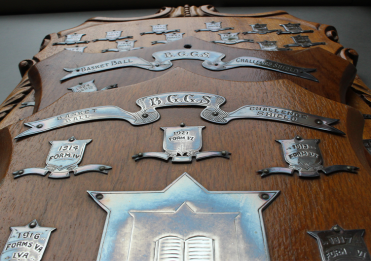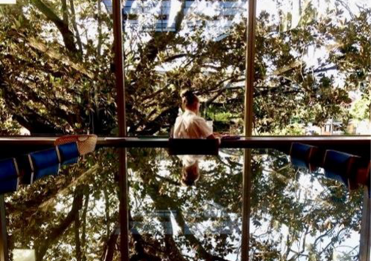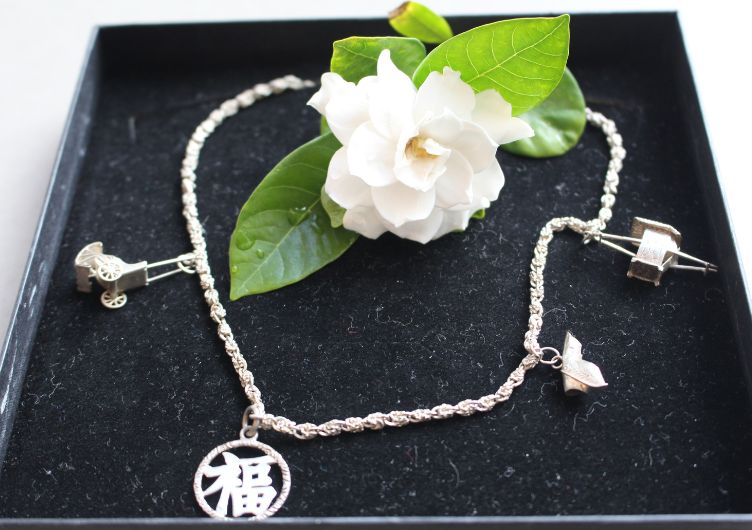
Ella Reinhold's necklace.
A delicate charm necklace resides in the Grammar Archive collection. An unusual acquisition with no outward appearance of a Grammar connection. Who would have thought that with careful research, its origin would be discovered in academic excellence and the desire of the Old Girls Association to celebrate outstanding scholarship in Year 10? More about this necklace and its intriguing story later!
Three public examinations were pivotal in the history of education in Queensland. The first was the State Scholarship Examination, available to girls from 1877. Students sat this examination in their last year of primary school, and the scholarship allowed them three years of education at any Grammar school. From 1914, these Secondary Scholarships were offered for two years at approved secondary schools to all pupils who obtained 50 per cent or more in the annual Scholarship Examination.
The other two Public Examinations were at the secondary school level and, until the establishment of The University of Queensland in 1910, these senior school examinations were set by the Universities of Melbourne and Sydney. Students in Fourth Form (Year 10) sat the Sydney Junior and Sixth Formers (Year 12s) sat the Senior Examinations, the latter being used to select university entrants. Matriculation requirements included both Senior and Junior subjects and the Junior Examination was, therefore, initially an integral part of entrance to a particular university course (Radford, 1970, p. 19).
One of the first decisions the Old Girls Association made on its inception in 1899 was to donate a prize to be awarded to the best Junior student of the Sydney Junior Public Examination. Their intent was to reward the student for her achievement and to encourage her to continue her studies towards a higher education. This seems straightforward. However, the 1930 December Brisbane Girls Grammar School magazine reveals an interesting problem with which the Old Girls Association had been grappling over several years: the selection and presentation of The Old Girls’ Prize. The Old Girls Association Report noted that ‘in the early years there were long and serious discussions as to what form it should take and for what it should be given’.
In her 1907 Head Mistress’s Report, Milisent Wilkinson noted that the Old Girls Association donated a prize annually to the best Sydney Junior candidate and commented that it was unusual as this was the first award recognising a student‘s hard work and achievement beyond the School walls.

Extract from 1907 Headmistress's Annual Report.
In 1901 The Old Girls’ Prize was awarded to Violet Moffat (1903) who was the top student in this external examination. The Prize must have been highly regarded as it was listed on the ‘Special Prize List’, along with the Lady Lilley Medal, the Wight Memorial Medal, and the Esther Beanland Medal.
In 1902 the award was shared by the top two Junior Prize winners—Elizabeth ‘Lizzie’ Mills (1902) and Clara Smith (1904)—but in the long list of prize winners an anomaly occurred in 1903 when The Old Girls’ Prize was awarded to Muriel Ramsey (1903), a girl in the Upper School, who took the highest place in General Knowledge!
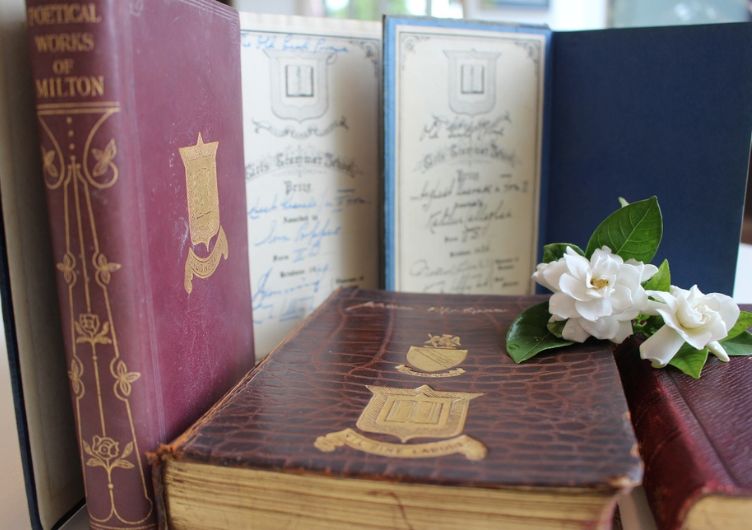
A selection of Old Girls' Prize Books found in the Archive Collection.
What had happened to the top Sydney Junior candidate and to The Old Girls’ Prize in 1903? Ella Reinhold (1905), who had been the top Sydney Junior candidate, did not receive The Old Girls’ Prize that year and the reason for this is complicated and involves some explanation of the educational and family situations for girls in the early 20th century. The Junior and Senior Examinations were conducted at the end of each year which meant the results were not announced until the following year—and herein lies the problem.
The Junior prize winner would have to wait until the following year’s Prize Giving, when she was in Form V (Year 11), to receive her prize. However, many students had left school after their Junior year. They either joined the workforce, because to continue into Senior was beyond the economic reach of many families, and these young girls took up employment either immediately as clerks, cadets, apprentices, trainee nurses, shop assistants, or later, post-Junior vocational courses. The Junior Examination was accepted as a suitable standard for entry to these positions (Radford, 1970, p. 64). Those who did not go out to work were needed at home to help look after younger siblings or elderly family members.
Eileen Harrison (Reimers, 1934) commented, in her Past Student Survey, that ‘there were many very clever girls with me at BGGS at the time (Depression era) whose parents were unable to keep them there after Junior’.
In her 1917 Annual Report, Annie Mackay expressed her dismay at the situation these girls were in, and remarked that most girls who had finished their two-year scholarship left school ‘just when they were old enough to begin to get a grip of secondary school work…’.
To solve this dilemma members of the Old Girls Association committee decided that The Old Girls’ Prize should be awarded to the best student in Form IV. It is interesting to note that even as late as 1968 still only 37 per cent of Queensland students who sat the Junior Examinations at the end of the year went on to Year 11.
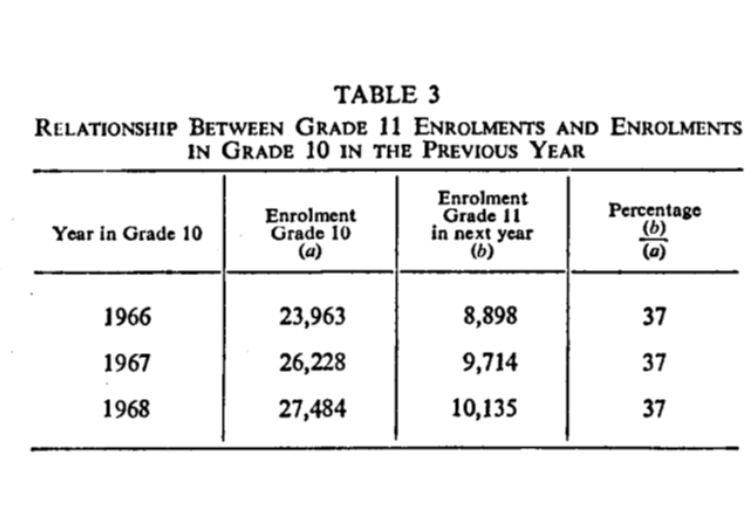
Table 3 Page 64 of the 1970 Report chaired by William Radford for the Department of Education, Queensland titled 'Public Examinations for Queensland Secondary School Students'.
The Old Girls’ Prize continued to be awarded to the top Form IV pupil for the next 59 years. In 1977, it was awarded to the Dux of Fourth Form, and in 1978 it went to the Dux of Year 10, Elizabeth Dutney (1980), who appears to have been the last Junior student to receive it.
And now we return to the charm necklace. What happened when Ella Reinhold (1905), the top Junior Examination student, who should have received The Old Girls’ Prize in 1903? Ella left school after her Junior year to join the workforce and help with her family. In 1911, she married Frank Allsop and they had two daughters, Joan (1930) and Marjorie (1937), who both attended Girls Grammar.
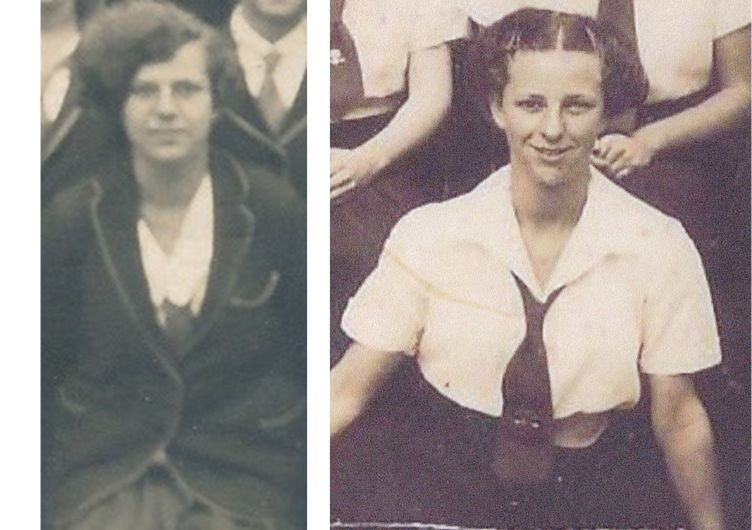
Left: 1930 Joan Allsop in Sixth Form; Right: 1937 Marjorie Allsop
In 1990, Joan donated a small silver charm necklace to the School, and in her letter to the Principal, Judith Hancock (18 June 1990), Joan explained that the necklace had been given to her mother, Ella, by Miss Wilkinson, Head Mistress at the time, on her return from a holiday in China. Joan went on to explain ‘…because the OGA Prize was consequently given that year for some other purpose—the only occasion on which it has not been awarded to the top Junior’, Milisent Wilkinson gave Ella this delicate silver necklace containing four charms—a rickshaw, a slipper for bound feet, a Chinese sedan chair, and a Good Fortune/Good Blessing medallion—to compensate her for not receiving The Old Girls’ Prize.
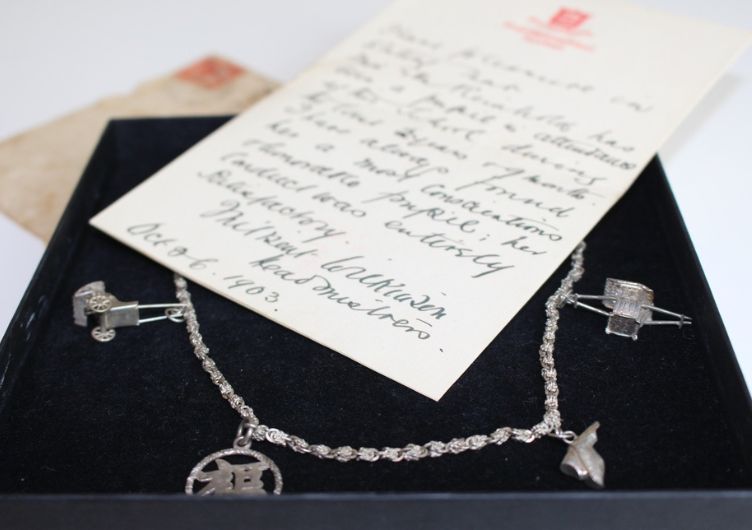
The charm necklace given to Ella Reinhold by Milisent Wilkinson in 1903.
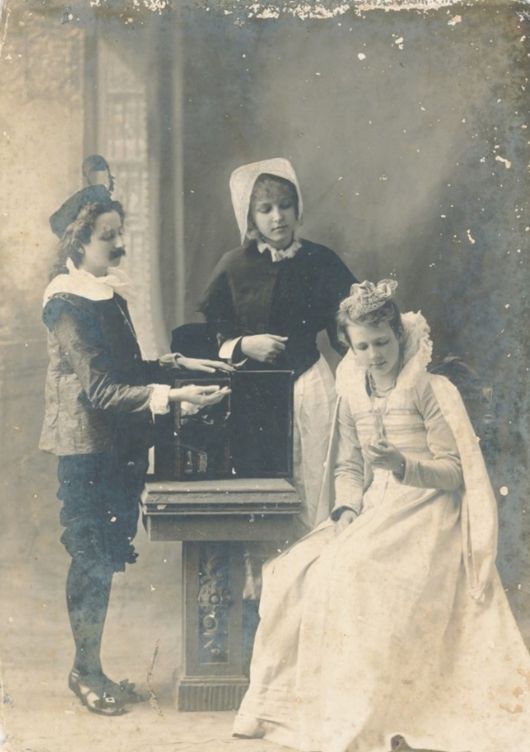
1902: A scene from 'Kenilworth' (Left to Right: Elsie Aravandino, Ella Reinhold, and Hilda Kennedy).
Ella Reinhold’s silver charm necklace is the one significant exception to the Book Prizes that were always given to winners of The Old Girls’ Prize. The School archival collection includes several of these books, donated by past students. Joan Allsop won the Old Girls’ Prize, The Works of Shakespeare, in 1928, her Fourth Form year. How appropriate that Joan should have won the prize that should have been her mother’s all those years before. One wonders whether the studious Ella would have preferred a book like her daughter’s, or the necklace so thoughtfully gifted to her by her Head Mistress.
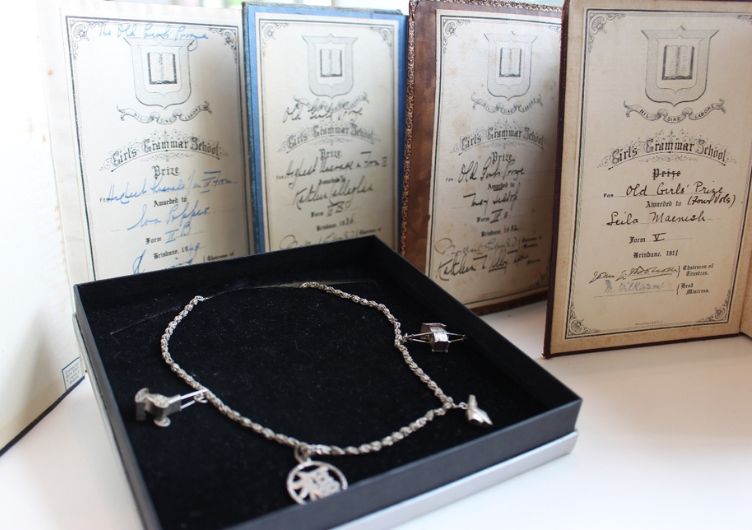
Old Girls' Prize Books of Eva Popper (1951), Kathleen Callaghan (1938), May Jessop (1934) and Leila Macnish (1913) with Ella Reinhold’s Chinese necklace.
Jenny Davis
Research Officer – Sesquicentenary
References:
Allsop, Joan Unpublished letter to Principal, Judith Hancock, 18 June 1990 – BGGS Archive Collection.
BGGS 1907 Annual Report, Head Mistress’s Report, Milisent Wilkinson.
BGGS 1917 Annual Report, Head Mistress’s Report, Annie Mackay.
Bow, Betty (BGGS 1944) – 1993 Past Student Survey – BGGS Archive Collection.
Brisbane Girls Grammar School Magazine, 1930 December n.p. ‘Old Girls’ Association: Early history’.
Harrison, Eileen nee Reimers (BGGS 1934) – Past Student Survey – BGGS Archive Collection.
Radford, William (Chair) 1970 Report, The Department of Education; Queensland, “Public Examinations for Queensland Secondary School Students”.
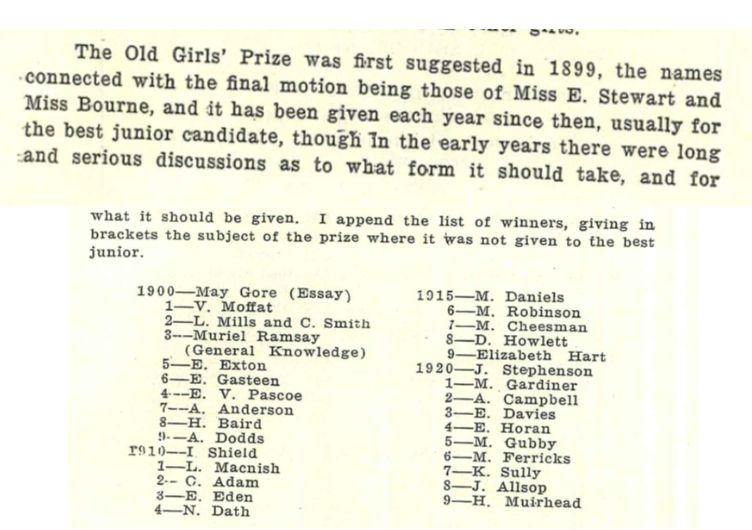
1930 BGGS magazine, OGA report containing the list of Old Girls' Prize winners.


